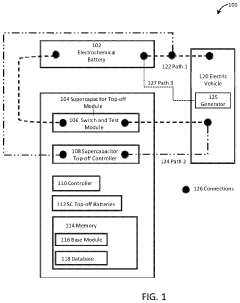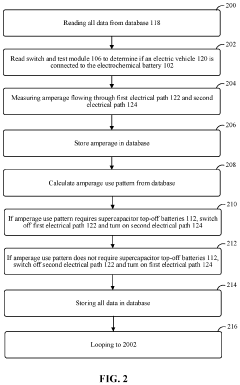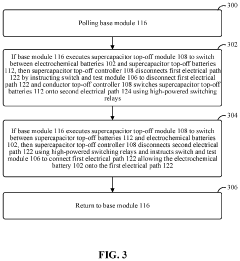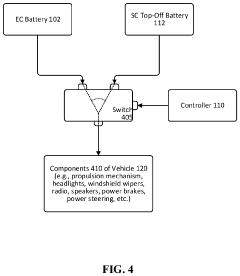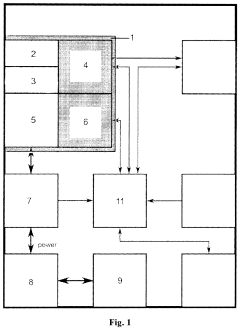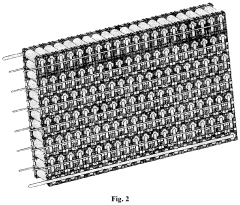Supercapacitor vs Battery: When to Choose Which for Grid and Microgrid Applications
AUG 21, 202510 MIN READ
Generate Your Research Report Instantly with AI Agent
Patsnap Eureka helps you evaluate technical feasibility & market potential.
Energy Storage Background and Objectives
Energy storage technologies have evolved significantly over the past decades, transitioning from simple mechanical systems to sophisticated electrochemical solutions. The global energy landscape is undergoing a profound transformation, driven by increasing renewable energy integration, growing electricity demand, and the imperative to reduce carbon emissions. This evolution has positioned energy storage as a critical component in modern electrical grid infrastructure, enabling greater flexibility, reliability, and efficiency.
Historically, pumped hydro storage dominated the utility-scale energy storage market, accounting for over 90% of global capacity. However, the past decade has witnessed remarkable advancements in electrochemical storage technologies, particularly lithium-ion batteries and supercapacitors, which have expanded the application possibilities across various grid scales.
The fundamental objective of energy storage in grid applications is to balance supply and demand by storing excess energy during periods of low demand or high generation and discharging during peak demand or generation shortfalls. This capability becomes increasingly valuable as intermittent renewable energy sources like solar and wind constitute a larger portion of the generation mix.
Batteries and supercapacitors represent two distinct approaches to electrochemical energy storage, each with unique characteristics that determine their suitability for specific grid applications. Batteries store energy through chemical reactions, offering high energy density but moderate power density and cycle life. Conversely, supercapacitors store energy electrostatically, providing exceptional power density and cycle life but limited energy density.
The technical objectives for grid and microgrid energy storage systems typically include enhancing grid stability through frequency regulation and voltage support, enabling peak shaving and load shifting to reduce infrastructure costs, providing backup power during outages, and facilitating renewable energy integration by mitigating intermittency issues.
Recent market projections indicate that the global grid-scale energy storage market is expected to grow at a CAGR of approximately 20-25% through 2030, reaching an estimated value of $15-20 billion. This growth is primarily driven by declining technology costs, supportive regulatory frameworks, and increasing renewable energy penetration.
The selection between batteries and supercapacitors for grid applications requires careful consideration of technical requirements, economic factors, and operational constraints. Understanding the fundamental differences between these technologies, their respective strengths and limitations, and their optimal application scenarios is essential for developing effective energy storage strategies that can support the transition to a more sustainable and resilient electrical grid infrastructure.
Historically, pumped hydro storage dominated the utility-scale energy storage market, accounting for over 90% of global capacity. However, the past decade has witnessed remarkable advancements in electrochemical storage technologies, particularly lithium-ion batteries and supercapacitors, which have expanded the application possibilities across various grid scales.
The fundamental objective of energy storage in grid applications is to balance supply and demand by storing excess energy during periods of low demand or high generation and discharging during peak demand or generation shortfalls. This capability becomes increasingly valuable as intermittent renewable energy sources like solar and wind constitute a larger portion of the generation mix.
Batteries and supercapacitors represent two distinct approaches to electrochemical energy storage, each with unique characteristics that determine their suitability for specific grid applications. Batteries store energy through chemical reactions, offering high energy density but moderate power density and cycle life. Conversely, supercapacitors store energy electrostatically, providing exceptional power density and cycle life but limited energy density.
The technical objectives for grid and microgrid energy storage systems typically include enhancing grid stability through frequency regulation and voltage support, enabling peak shaving and load shifting to reduce infrastructure costs, providing backup power during outages, and facilitating renewable energy integration by mitigating intermittency issues.
Recent market projections indicate that the global grid-scale energy storage market is expected to grow at a CAGR of approximately 20-25% through 2030, reaching an estimated value of $15-20 billion. This growth is primarily driven by declining technology costs, supportive regulatory frameworks, and increasing renewable energy penetration.
The selection between batteries and supercapacitors for grid applications requires careful consideration of technical requirements, economic factors, and operational constraints. Understanding the fundamental differences between these technologies, their respective strengths and limitations, and their optimal application scenarios is essential for developing effective energy storage strategies that can support the transition to a more sustainable and resilient electrical grid infrastructure.
Market Analysis for Grid Storage Solutions
The global energy storage market for grid applications is experiencing unprecedented growth, driven by the increasing integration of renewable energy sources and the need for grid stability. As of 2023, the grid storage market has reached approximately $27 billion and is projected to grow at a CAGR of 24% through 2030, potentially reaching $112 billion by the end of the decade.
Lithium-ion batteries currently dominate the market with over 70% market share in grid storage applications. This dominance stems from their established manufacturing infrastructure, decreasing costs (which have fallen by 89% since 2010), and relatively high energy density. However, supercapacitors are carving out specific niches, particularly in applications requiring rapid response times and high power delivery.
Regional analysis reveals distinct market characteristics. North America leads in grid-scale battery deployments, with the United States accounting for approximately 43% of global installations. The Asia-Pacific region, particularly China, is experiencing the fastest growth rate at 29% annually, driven by massive renewable energy integration and government mandates for energy storage. Europe follows with significant deployments in Germany, the UK, and Spain, focusing on frequency regulation and renewable integration.
Market segmentation by application shows that frequency regulation represents 31% of current grid storage deployments, where supercapacitors excel due to their rapid charge-discharge capabilities and cycle life advantages. Peak shaving applications constitute 27% of the market, typically favoring battery solutions for their energy density. Renewable integration accounts for 24%, with hybrid systems gaining traction to leverage the complementary benefits of both technologies.
Customer demand analysis indicates that utilities prioritize total cost of ownership over initial capital expenditure, with increasing emphasis on system longevity and degradation profiles. This trend favors supercapacitors in specific use cases despite their higher upfront costs, as their million-plus cycle life significantly outperforms batteries in high-cycling applications.
Emerging market opportunities include the microgrid sector, growing at 28% annually, where hybrid storage solutions combining batteries and supercapacitors show particular promise. The electric vehicle charging infrastructure market also presents significant potential for supercapacitor deployment, especially for fast-charging applications where power density is critical.
Pricing trends show supercapacitor costs decreasing at approximately 12% annually, while battery costs are declining at a slower rate of 8% after years of steeper reductions. This narrowing cost differential is expected to accelerate supercapacitor adoption in grid applications where their technical advantages can be monetized.
Lithium-ion batteries currently dominate the market with over 70% market share in grid storage applications. This dominance stems from their established manufacturing infrastructure, decreasing costs (which have fallen by 89% since 2010), and relatively high energy density. However, supercapacitors are carving out specific niches, particularly in applications requiring rapid response times and high power delivery.
Regional analysis reveals distinct market characteristics. North America leads in grid-scale battery deployments, with the United States accounting for approximately 43% of global installations. The Asia-Pacific region, particularly China, is experiencing the fastest growth rate at 29% annually, driven by massive renewable energy integration and government mandates for energy storage. Europe follows with significant deployments in Germany, the UK, and Spain, focusing on frequency regulation and renewable integration.
Market segmentation by application shows that frequency regulation represents 31% of current grid storage deployments, where supercapacitors excel due to their rapid charge-discharge capabilities and cycle life advantages. Peak shaving applications constitute 27% of the market, typically favoring battery solutions for their energy density. Renewable integration accounts for 24%, with hybrid systems gaining traction to leverage the complementary benefits of both technologies.
Customer demand analysis indicates that utilities prioritize total cost of ownership over initial capital expenditure, with increasing emphasis on system longevity and degradation profiles. This trend favors supercapacitors in specific use cases despite their higher upfront costs, as their million-plus cycle life significantly outperforms batteries in high-cycling applications.
Emerging market opportunities include the microgrid sector, growing at 28% annually, where hybrid storage solutions combining batteries and supercapacitors show particular promise. The electric vehicle charging infrastructure market also presents significant potential for supercapacitor deployment, especially for fast-charging applications where power density is critical.
Pricing trends show supercapacitor costs decreasing at approximately 12% annually, while battery costs are declining at a slower rate of 8% after years of steeper reductions. This narrowing cost differential is expected to accelerate supercapacitor adoption in grid applications where their technical advantages can be monetized.
Technical Challenges in Energy Storage Systems
Energy storage systems for grid and microgrid applications face numerous technical challenges that significantly impact their performance, reliability, and economic viability. One of the primary challenges is the inherent trade-off between power density and energy density. Batteries typically offer high energy density but limited power capabilities, while supercapacitors provide excellent power density but lower energy storage capacity. This fundamental limitation necessitates careful system design and often requires hybrid solutions to meet both short-term power demands and longer-term energy requirements.
Cycle life degradation presents another significant challenge, particularly for battery technologies. Most battery chemistries experience capacity fade over time, with performance deteriorating after hundreds to thousands of cycles depending on the technology. This degradation is accelerated by deep discharge cycles, high temperatures, and rapid charging/discharging rates. Supercapacitors offer superior cyclability (often exceeding 500,000 cycles) but at the cost of lower energy density, creating a complex engineering challenge for grid applications requiring both longevity and substantial energy storage.
Thermal management remains a critical technical hurdle for both technologies. Batteries generate significant heat during rapid charging and discharging, requiring sophisticated cooling systems to prevent thermal runaway and ensure safe operation. Even supercapacitors, though generally safer, experience efficiency losses and accelerated aging at elevated temperatures. The thermal management challenge becomes particularly acute in grid-scale installations where thousands of cells must be monitored and maintained within optimal temperature ranges.
Safety concerns present ongoing technical challenges, especially for large-scale deployments. Battery systems, particularly those using lithium-ion chemistry, carry inherent risks of fire and explosion if damaged or improperly managed. While supercapacitors generally pose lower fire risks, they present unique safety challenges related to their ability to discharge extremely high currents rapidly, potentially causing electrical arcing or component damage.
System integration and control algorithms represent another layer of technical complexity. Effectively managing the state of charge, optimizing power flow, and coordinating between different storage technologies in hybrid systems requires sophisticated battery management systems (BMS) and energy management systems (EMS). These systems must accurately predict available capacity, prevent over-charging or over-discharging, balance cells, and communicate with broader grid management systems.
Scalability challenges emerge when moving from small demonstration projects to utility-scale implementations. Manufacturing consistency, quality control, and supply chain reliability become critical factors affecting system performance and reliability. Additionally, the environmental impact of manufacturing and end-of-life disposal presents growing technical challenges as deployment scales increase, requiring innovations in recycling technologies and sustainable material sourcing.
Cycle life degradation presents another significant challenge, particularly for battery technologies. Most battery chemistries experience capacity fade over time, with performance deteriorating after hundreds to thousands of cycles depending on the technology. This degradation is accelerated by deep discharge cycles, high temperatures, and rapid charging/discharging rates. Supercapacitors offer superior cyclability (often exceeding 500,000 cycles) but at the cost of lower energy density, creating a complex engineering challenge for grid applications requiring both longevity and substantial energy storage.
Thermal management remains a critical technical hurdle for both technologies. Batteries generate significant heat during rapid charging and discharging, requiring sophisticated cooling systems to prevent thermal runaway and ensure safe operation. Even supercapacitors, though generally safer, experience efficiency losses and accelerated aging at elevated temperatures. The thermal management challenge becomes particularly acute in grid-scale installations where thousands of cells must be monitored and maintained within optimal temperature ranges.
Safety concerns present ongoing technical challenges, especially for large-scale deployments. Battery systems, particularly those using lithium-ion chemistry, carry inherent risks of fire and explosion if damaged or improperly managed. While supercapacitors generally pose lower fire risks, they present unique safety challenges related to their ability to discharge extremely high currents rapidly, potentially causing electrical arcing or component damage.
System integration and control algorithms represent another layer of technical complexity. Effectively managing the state of charge, optimizing power flow, and coordinating between different storage technologies in hybrid systems requires sophisticated battery management systems (BMS) and energy management systems (EMS). These systems must accurately predict available capacity, prevent over-charging or over-discharging, balance cells, and communicate with broader grid management systems.
Scalability challenges emerge when moving from small demonstration projects to utility-scale implementations. Manufacturing consistency, quality control, and supply chain reliability become critical factors affecting system performance and reliability. Additionally, the environmental impact of manufacturing and end-of-life disposal presents growing technical challenges as deployment scales increase, requiring innovations in recycling technologies and sustainable material sourcing.
Current Grid Storage Implementation Approaches
01 Energy density and power density characteristics
Supercapacitors and batteries exhibit different energy and power density profiles. Batteries typically offer higher energy density, storing more energy per unit volume or weight, making them suitable for long-duration applications. Supercapacitors, on the other hand, excel in power density, delivering energy rapidly for high-power applications. These fundamental differences determine their suitability for various applications, from electric vehicles to renewable energy storage systems.- Energy density and power density characteristics: Supercapacitors and batteries exhibit different energy and power density profiles. Batteries typically have higher energy density, storing more energy per unit volume or weight, while supercapacitors excel in power density, delivering energy rapidly for high-power applications. These fundamental differences determine their suitability for various applications, from electric vehicles requiring sustained energy release to systems needing quick power bursts. Understanding these characteristics is crucial for designing optimal energy storage solutions.
- Charging and discharging performance: The charging and discharging behaviors of supercapacitors and batteries significantly differ in terms of efficiency, speed, and cycle life. Supercapacitors can be charged and discharged rapidly without significant degradation, supporting millions of cycles, while batteries typically offer slower charging rates and fewer lifetime cycles. These characteristics affect their application in regenerative braking systems, pulse power applications, and energy harvesting technologies where charging speed and efficiency are critical factors.
- Temperature performance and operational range: Temperature significantly impacts the performance of both supercapacitors and batteries. Supercapacitors generally maintain better performance across wider temperature ranges, particularly in cold environments, while batteries often experience reduced capacity and efficiency at temperature extremes. This characteristic influences their deployment in outdoor applications, automotive systems operating in varied climates, and industrial settings with temperature fluctuations. Thermal management systems may be required to optimize performance and prevent degradation.
- Hybrid and integrated energy storage systems: Hybrid systems combining supercapacitors and batteries leverage the complementary strengths of both technologies. These integrated solutions utilize supercapacitors for high-power, short-duration demands while batteries provide sustained energy supply. Such hybrid approaches optimize overall system performance, extending battery life by reducing high-current stress, improving energy efficiency, and enhancing response to variable loads. Advanced management systems coordinate the operation of both components to maximize performance and longevity.
- Monitoring and management systems: Sophisticated monitoring and management systems are essential for optimizing the performance of supercapacitors and batteries. These systems track critical parameters including state of charge, temperature, voltage, and health status in real-time. Advanced algorithms predict performance degradation, optimize charging protocols, and balance loads across cells. Effective management systems extend operational life, enhance safety by preventing overcharging or overheating, and maximize energy efficiency through intelligent control of charging and discharging cycles.
02 Charging and discharging efficiency
The charging and discharging characteristics significantly differ between supercapacitors and batteries. Supercapacitors can be charged and discharged rapidly with high efficiency, often completing thousands of cycles without significant degradation. Batteries typically have slower charging rates and lower cycle life. The charging efficiency, discharge rates, and cycle stability are critical performance parameters that determine the operational lifetime and application suitability of these energy storage technologies.Expand Specific Solutions03 Temperature performance and operational range
Temperature significantly affects the performance of both supercapacitors and batteries. Supercapacitors generally maintain better performance across a wider temperature range, particularly in cold environments where batteries often suffer from reduced capacity and power output. The operational temperature range impacts energy storage efficiency, self-discharge rates, and overall system reliability, making thermal management a critical consideration in energy storage system design.Expand Specific Solutions04 Hybrid and integrated energy storage systems
Hybrid systems combining supercapacitors and batteries leverage the complementary strengths of both technologies. These integrated solutions utilize batteries for energy-intensive requirements and supercapacitors for power-intensive demands, optimizing overall system performance. Such hybrid configurations can extend battery life by handling power surges, improve system response times, and enhance energy efficiency in applications ranging from automotive to grid storage systems.Expand Specific Solutions05 Lifespan and degradation mechanisms
The lifespan and degradation patterns differ significantly between supercapacitors and batteries. Supercapacitors typically offer longer operational lifespans with gradual capacity fade, while batteries experience more complex degradation mechanisms including capacity loss, increased internal resistance, and potential safety issues over time. Understanding these degradation mechanisms is crucial for predicting performance, scheduling maintenance, and optimizing the total cost of ownership for energy storage systems.Expand Specific Solutions
Key Industry Players and Competitive Landscape
The supercapacitor versus battery market for grid and microgrid applications is currently in a growth phase, with an expanding market size driven by increasing renewable energy integration. Technologically, supercapacitors excel in high-power, rapid-cycling applications while batteries dominate in energy storage capacity. Key players demonstrate varying levels of technological maturity: Shanghai Aowei Technology and LS Materials lead in supercapacitor development; ABB Group, Robert Bosch, and IBM offer integrated grid solutions; while research institutions like Fraunhofer-Gesellschaft, CEA, and Chinese academic institutions (Dalian University of Technology, Institute of Electrical Engineering CAS) drive innovation. Korea Electric Power and Vertiv Tech represent utility and infrastructure perspectives, creating a competitive landscape where application-specific requirements determine technology selection.
ABB Group
Technical Solution: ABB Group has developed a comprehensive hybrid energy storage system that strategically combines supercapacitors and batteries for grid and microgrid applications. Their PowerStore solution integrates flywheel or battery energy storage with advanced control systems to stabilize power networks. For grid applications, ABB employs supercapacitors for high-power, short-duration needs such as frequency regulation and voltage support, while utilizing lithium-ion batteries for energy time-shifting and longer-duration backup. Their microgrid solutions feature a modular architecture where supercapacitors handle peak power demands and rapid cycling requirements, while batteries manage sustained energy delivery. ABB's PowerStore technology can respond within milliseconds to grid fluctuations, providing synthetic inertia that conventional generators typically supply. The system includes sophisticated energy management software that optimizes the operation of both storage technologies based on real-time grid conditions, load profiles, and renewable generation forecasts.
Strengths: ABB's hybrid approach maximizes the complementary characteristics of both technologies, extending battery life by handling high-power transients with supercapacitors. Their solutions offer millisecond response times and modular scalability. Weaknesses: Higher initial capital costs compared to single-technology solutions and requires more complex control systems and integration expertise.
Robert Bosch GmbH
Technical Solution: Robert Bosch GmbH has engineered an advanced hybrid energy storage solution that strategically integrates supercapacitors and batteries for grid and microgrid applications. Their system employs a modular architecture where supercapacitors handle high-power, short-duration demands while various battery technologies manage sustained energy delivery requirements. For grid applications, Bosch's solution utilizes supercapacitors for primary frequency regulation, voltage support, and power quality management, leveraging their exceptional power density and rapid response capabilities. These supercapacitors can respond within milliseconds to grid fluctuations, providing critical stability during transient events. For energy-intensive functions requiring longer duration, the system transitions to advanced lithium-ion battery technologies optimized for grid applications. In microgrid implementations, particularly those supporting critical infrastructure or industrial facilities, their approach employs supercapacitors to manage rapid load changes and smooth renewable energy integration, while battery systems provide bulk energy storage for load shifting and backup power. Bosch's energy management system incorporates sophisticated algorithms that continuously optimize the operation strategy based on usage patterns, forecasted renewable generation, and grid conditions.
Strengths: Bosch's solution demonstrates exceptional response times for grid stabilization while significantly extending battery lifetime through reduced cycling stress. Their modular approach allows for customized configurations based on specific application requirements and enables phased implementation. Weaknesses: Higher system complexity requires sophisticated control algorithms and integration expertise, with higher initial capital costs despite potentially lower lifetime costs through extended component longevity.
Critical Technologies in Supercapacitor and Battery Systems
Supercapacitor to electrochemical hybrid top-off system
PatentPendingUS20230211677A1
Innovation
- A hybrid power system for electric vehicles incorporating at least one electrochemical battery and one supercapacitor top-off battery, with a controller managing the switching between the two to optimize power delivery based on current flow, temperature, and predicted load, ensuring efficient energy use and extended battery life.
Combined power supply
PatentInactiveUS20220238943A1
Innovation
- A combined power supply system comprising a lithium-ion battery and a supercapacitor, with an active balancing system, a protection unit, a current sensor, and a controller, which manages energy distribution between the two components to minimize losses and extend battery life, using a universal battery module mounted on an electric bicycle, allowing for efficient energy recovery and storage.
Regulatory Framework for Grid Energy Storage
The regulatory landscape for grid energy storage technologies is complex and evolving rapidly as governments worldwide recognize the critical role of energy storage in grid stabilization and renewable energy integration. In the United States, FERC Order 841 represents a landmark regulation that requires regional transmission organizations to establish market rules allowing energy storage resources to participate in wholesale electricity markets. This has created significant opportunities for both battery and supercapacitor technologies, though with different compliance requirements based on their technical characteristics.
The European Union has implemented the Clean Energy Package, which includes specific provisions for energy storage deployment and operation. These regulations generally favor technology-neutral approaches but contain technical requirements that inherently advantage certain storage technologies. For instance, batteries often benefit from regulations focused on longer-duration storage needs, while supercapacitors may find advantages in regulations addressing frequency regulation and power quality services.
Safety standards represent another critical regulatory dimension. UL 1973 and IEC 62619 standards govern battery safety for grid applications, imposing rigorous testing requirements for thermal runaway prevention and management. Supercapacitors face different but equally stringent standards under IEC 62391 and UL 810A, with particular emphasis on voltage management and cycle life verification. These safety regulations significantly impact deployment costs and timelines for both technologies.
Environmental regulations also shape technology selection decisions. Battery technologies, particularly lithium-ion, face increasing scrutiny regarding end-of-life management and recycling requirements. The EU Battery Directive and emerging regulations in North America mandate specific recycling rates and material recovery targets. Supercapacitors generally face less stringent end-of-life regulations due to their different material composition, potentially offering regulatory advantages in environmentally sensitive deployments.
Grid interconnection standards further differentiate the regulatory treatment of these technologies. IEEE 1547 and its international equivalents establish technical requirements for connecting distributed energy resources to the grid. These standards typically include response time requirements that supercapacitors can more easily meet, while batteries excel under capacity and duration requirements. Recent regulatory trends indicate movement toward performance-based standards rather than technology-specific requirements, potentially leveling the playing field between these competing storage technologies.
Emerging regulatory frameworks for microgrid applications are increasingly recognizing the complementary nature of batteries and supercapacitors. Regulations in Japan, Australia, and parts of the United States now explicitly allow for hybrid storage systems that leverage the strengths of multiple technologies, creating new opportunities for integrated solutions that optimize both technologies' characteristics under a unified regulatory framework.
The European Union has implemented the Clean Energy Package, which includes specific provisions for energy storage deployment and operation. These regulations generally favor technology-neutral approaches but contain technical requirements that inherently advantage certain storage technologies. For instance, batteries often benefit from regulations focused on longer-duration storage needs, while supercapacitors may find advantages in regulations addressing frequency regulation and power quality services.
Safety standards represent another critical regulatory dimension. UL 1973 and IEC 62619 standards govern battery safety for grid applications, imposing rigorous testing requirements for thermal runaway prevention and management. Supercapacitors face different but equally stringent standards under IEC 62391 and UL 810A, with particular emphasis on voltage management and cycle life verification. These safety regulations significantly impact deployment costs and timelines for both technologies.
Environmental regulations also shape technology selection decisions. Battery technologies, particularly lithium-ion, face increasing scrutiny regarding end-of-life management and recycling requirements. The EU Battery Directive and emerging regulations in North America mandate specific recycling rates and material recovery targets. Supercapacitors generally face less stringent end-of-life regulations due to their different material composition, potentially offering regulatory advantages in environmentally sensitive deployments.
Grid interconnection standards further differentiate the regulatory treatment of these technologies. IEEE 1547 and its international equivalents establish technical requirements for connecting distributed energy resources to the grid. These standards typically include response time requirements that supercapacitors can more easily meet, while batteries excel under capacity and duration requirements. Recent regulatory trends indicate movement toward performance-based standards rather than technology-specific requirements, potentially leveling the playing field between these competing storage technologies.
Emerging regulatory frameworks for microgrid applications are increasingly recognizing the complementary nature of batteries and supercapacitors. Regulations in Japan, Australia, and parts of the United States now explicitly allow for hybrid storage systems that leverage the strengths of multiple technologies, creating new opportunities for integrated solutions that optimize both technologies' characteristics under a unified regulatory framework.
Environmental Impact Assessment
The environmental impact of energy storage technologies is a critical consideration in grid and microgrid applications, particularly as sustainability becomes increasingly important in energy system planning. Supercapacitors and batteries present distinctly different environmental profiles throughout their lifecycles, from raw material extraction to end-of-life management.
Supercapacitors generally demonstrate lower environmental impact in several key areas. Their primary components—activated carbon, aluminum, and electrolytes—typically require less environmentally harmful extraction processes compared to battery materials. The manufacturing process for supercapacitors is also less energy-intensive, resulting in a smaller carbon footprint during production. Additionally, supercapacitors contain fewer toxic materials, with most commercial models free from heavy metals like lead, mercury, or cadmium that are often present in certain battery types.
The operational environmental advantages of supercapacitors include their exceptional cycle life, which can exceed 1,000,000 cycles compared to batteries' typical range of 500-10,000 cycles. This longevity significantly reduces waste generation and resource consumption associated with frequent replacements. Furthermore, supercapacitors operate efficiently across a wider temperature range without requiring energy-intensive thermal management systems often needed for batteries.
Batteries, particularly lithium-ion technologies, present more complex environmental challenges. Their production involves mining lithium, cobalt, nickel, and other materials with significant ecological impacts, including habitat destruction, water pollution, and high carbon emissions. The manufacturing process is energy-intensive, with estimates suggesting that producing 1 kWh of lithium-ion battery capacity generates 150-200 kg of CO2 equivalent.
However, batteries are making environmental progress through technological advancements. Newer chemistries are reducing dependence on problematic materials like cobalt, while recycling technologies are improving to recover valuable components. Battery energy density improvements also mean fewer raw materials are needed per unit of energy storage, gradually reducing their environmental footprint.
End-of-life considerations reveal further distinctions. Supercapacitors are generally easier to recycle, with higher recovery rates for their materials. Battery recycling remains more challenging, though improving technologies and regulatory frameworks are enhancing recovery rates, particularly for lithium and cobalt.
For grid applications, the environmental decision between these technologies should consider the specific use case. Frequency regulation and power quality applications may benefit from supercapacitors' lower impact, while longer-duration storage may necessitate batteries despite their higher environmental cost. Hybrid systems combining both technologies often represent the optimal environmental solution, leveraging the strengths of each while minimizing their respective environmental drawbacks.
Supercapacitors generally demonstrate lower environmental impact in several key areas. Their primary components—activated carbon, aluminum, and electrolytes—typically require less environmentally harmful extraction processes compared to battery materials. The manufacturing process for supercapacitors is also less energy-intensive, resulting in a smaller carbon footprint during production. Additionally, supercapacitors contain fewer toxic materials, with most commercial models free from heavy metals like lead, mercury, or cadmium that are often present in certain battery types.
The operational environmental advantages of supercapacitors include their exceptional cycle life, which can exceed 1,000,000 cycles compared to batteries' typical range of 500-10,000 cycles. This longevity significantly reduces waste generation and resource consumption associated with frequent replacements. Furthermore, supercapacitors operate efficiently across a wider temperature range without requiring energy-intensive thermal management systems often needed for batteries.
Batteries, particularly lithium-ion technologies, present more complex environmental challenges. Their production involves mining lithium, cobalt, nickel, and other materials with significant ecological impacts, including habitat destruction, water pollution, and high carbon emissions. The manufacturing process is energy-intensive, with estimates suggesting that producing 1 kWh of lithium-ion battery capacity generates 150-200 kg of CO2 equivalent.
However, batteries are making environmental progress through technological advancements. Newer chemistries are reducing dependence on problematic materials like cobalt, while recycling technologies are improving to recover valuable components. Battery energy density improvements also mean fewer raw materials are needed per unit of energy storage, gradually reducing their environmental footprint.
End-of-life considerations reveal further distinctions. Supercapacitors are generally easier to recycle, with higher recovery rates for their materials. Battery recycling remains more challenging, though improving technologies and regulatory frameworks are enhancing recovery rates, particularly for lithium and cobalt.
For grid applications, the environmental decision between these technologies should consider the specific use case. Frequency regulation and power quality applications may benefit from supercapacitors' lower impact, while longer-duration storage may necessitate batteries despite their higher environmental cost. Hybrid systems combining both technologies often represent the optimal environmental solution, leveraging the strengths of each while minimizing their respective environmental drawbacks.
Unlock deeper insights with Patsnap Eureka Quick Research — get a full tech report to explore trends and direct your research. Try now!
Generate Your Research Report Instantly with AI Agent
Supercharge your innovation with Patsnap Eureka AI Agent Platform!
